The Greek Temples at Paestum
Wednesday 13th September 2006
We left the villa about mid-morning, with no problems about getting the car out as Adam had moved the car into a little driveway in front of the garage belong to the villa. Fortunata managed to communicate to me that the owner did not like us to park there but I ‘did not understand’ what she was saying and thought we were only there for a few more days so what were they going to do about it if we did not park in the impossible narrow spot next to the villa front wall and we had visions of being blocked in on the day that we were leaving to go back to Rome.
Paestum is about fifty kilometres south of Salerno so we had to drive along the very narrow coast road through Priano, Amalfi and Atrani until we could link up with a major road heading south. It was on this narrow coast road that we were squeezed into a stone wall along side the road, not a major issue just a bit of a scrape. I thought that the damage was done on our way to Ravello on a previous day, but when writing about this day trip I discovered that this was the actual day when the damage occurred.
We were a little surprised and how large and modern looking Salerno was; it appeared similar in size to Naples and with some pleasant beachside suburbs.
South of Salerno is a very flat coastal plain with many cheap looking holiday complexes that are a bit grotty and really did not inspire us to enjoy that part of the trip and filled us with some trepidation as to what Paestum might be like.
Ancient Poseidonia, founded along the Sele River by Greek colonists from Sybaris around 600 BCE (Before the Christian Era), became the Roma Colony of Paestum in 273 BCE. The town began to decline in the 1st century BCE due to malaria. Seismic disturbance and deforestation, (the local pines made excellent raw material for building ships) had gradually turned the area into marshland.
The inhabitants tried to combat the rising water level; they raised their streets and homes, or went to live on higher ground. It was at this time that the temple of Hera was made into a church by the then Christian population. Eventually however Paestum was abandoned for the nearby town of Capaccio.
The site of Paestum was first unearthed in the 18th century during the building of a road, but it is claimed that most of it remained undiscovered until the 1950’s. There is still excavation work taking place exposing more foundations of buildings etc; but ‘The Temples of Paestum’ were featured in a number of paintings of the area in the 18th century including works by Antonio Joli (1758) so the claims about it not being discovered until the 1950’s are spurious.
The Three Temples of Paestum, are excellent and make it a site well worth seeing, Rosalind claims that they are far better than the Acropolis in Athens.
The smallest temple, Temple of Hera, the Basilica was first thought to be civic building as it lacked any religious features, when in fact it is the oldest temple in Paestum, built around 530 BCE. It has nine front columns, eighteen side columns and two aisles divided by a row of columns.
The temple nearest the entrance to the site is now called the Temple of Ceres and was built around 500 BCE and for a long time was thought to have been dedicated to Athena, until a votive offering nearby, indicated that it was in fact a temple dedicated to Ceres. However I wonder about some of the ‘science’ of archaeology, and think perhaps someone may have just dropped a Ceres votive my mistake and now the archaeologists have grasped this ‘red herring’ and run with it, (I like mixed metaphors). The Temple of Ceres has six fluted columns at the front, thirteen lateral ones and an undivided cella.
Next to the Temple of Hera is the largest temple, now called the Temple of Neptune has also been the subject of debate about its dedication. Some claim that it was either dedicated to Apollo or Zeus, but for some reason unknown to me it is commonly called the Temple of Neptune. The Temple of Neptune was built in 450 BCE, and it is one of the most complete Greek temples in Europe. The Temple of Neptune has six front columns, fourteen side columns and its cella is divided into three aisles by two rows of two tier columns.

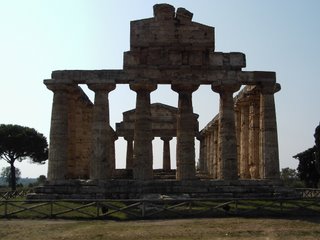 It was a very hot dry day, so Sheila elected to stay outside of the site and sit in the shade while Adam, Rosalind and I wandered around awestruck by the size and condition of the temples. Sheila could see all the temples from outside of the site as there is only a low metal picket fence around the site and it is only if you want to get up close and personal do you need to pay the entrance fee.
It was a very hot dry day, so Sheila elected to stay outside of the site and sit in the shade while Adam, Rosalind and I wandered around awestruck by the size and condition of the temples. Sheila could see all the temples from outside of the site as there is only a low metal picket fence around the site and it is only if you want to get up close and personal do you need to pay the entrance fee.
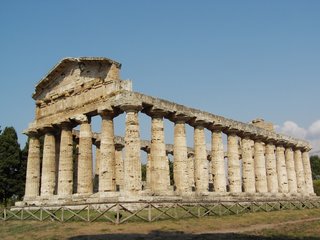

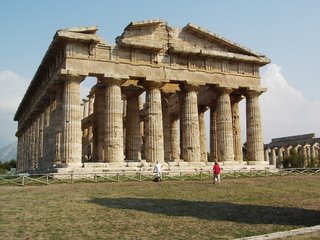
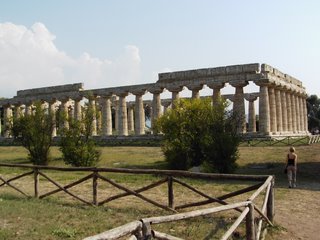
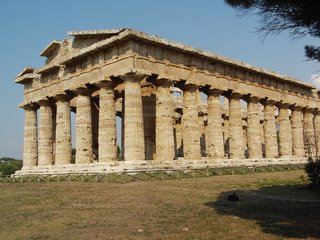
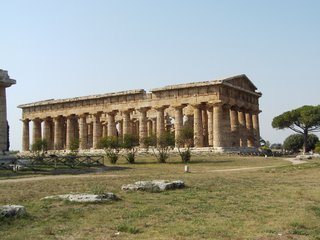
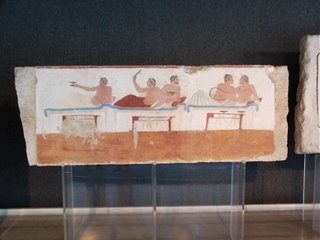
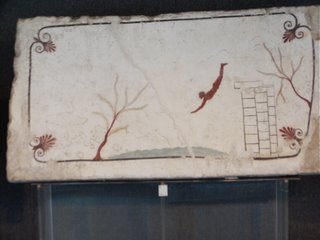 This famous fresco ‘Tomb of the Diver’ which dates from about 480BCE was discovered in 1968 about one kilometre from Paestum. Supposedly the image of the diver symbolises the passage to the afterlife. To me it just looks like someone diving off a diving tower into some water, but I guess that explanation would be too mundane for the academic archaeologists.
This famous fresco ‘Tomb of the Diver’ which dates from about 480BCE was discovered in 1968 about one kilometre from Paestum. Supposedly the image of the diver symbolises the passage to the afterlife. To me it just looks like someone diving off a diving tower into some water, but I guess that explanation would be too mundane for the academic archaeologists.
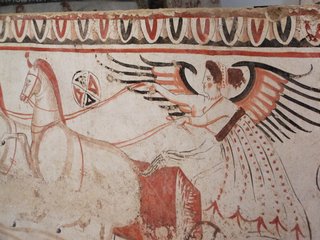 After the museum we feeling hungry and went into the café next door. On the menu was ‘chip pizza’, I thought that this was a mistake in interpretation/translation so just had to order it. Of course I had to eat it to destroy the evidence.
After the museum we feeling hungry and went into the café next door. On the menu was ‘chip pizza’, I thought that this was a mistake in interpretation/translation so just had to order it. Of course I had to eat it to destroy the evidence.
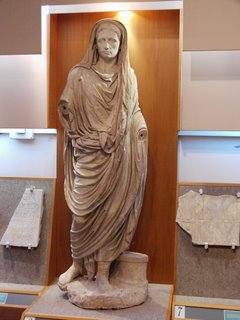
We left the villa about mid-morning, with no problems about getting the car out as Adam had moved the car into a little driveway in front of the garage belong to the villa. Fortunata managed to communicate to me that the owner did not like us to park there but I ‘did not understand’ what she was saying and thought we were only there for a few more days so what were they going to do about it if we did not park in the impossible narrow spot next to the villa front wall and we had visions of being blocked in on the day that we were leaving to go back to Rome.
Paestum is about fifty kilometres south of Salerno so we had to drive along the very narrow coast road through Priano, Amalfi and Atrani until we could link up with a major road heading south. It was on this narrow coast road that we were squeezed into a stone wall along side the road, not a major issue just a bit of a scrape. I thought that the damage was done on our way to Ravello on a previous day, but when writing about this day trip I discovered that this was the actual day when the damage occurred.
We were a little surprised and how large and modern looking Salerno was; it appeared similar in size to Naples and with some pleasant beachside suburbs.
South of Salerno is a very flat coastal plain with many cheap looking holiday complexes that are a bit grotty and really did not inspire us to enjoy that part of the trip and filled us with some trepidation as to what Paestum might be like.
Ancient Poseidonia, founded along the Sele River by Greek colonists from Sybaris around 600 BCE (Before the Christian Era), became the Roma Colony of Paestum in 273 BCE. The town began to decline in the 1st century BCE due to malaria. Seismic disturbance and deforestation, (the local pines made excellent raw material for building ships) had gradually turned the area into marshland.
The inhabitants tried to combat the rising water level; they raised their streets and homes, or went to live on higher ground. It was at this time that the temple of Hera was made into a church by the then Christian population. Eventually however Paestum was abandoned for the nearby town of Capaccio.
The site of Paestum was first unearthed in the 18th century during the building of a road, but it is claimed that most of it remained undiscovered until the 1950’s. There is still excavation work taking place exposing more foundations of buildings etc; but ‘The Temples of Paestum’ were featured in a number of paintings of the area in the 18th century including works by Antonio Joli (1758) so the claims about it not being discovered until the 1950’s are spurious.
The Three Temples of Paestum, are excellent and make it a site well worth seeing, Rosalind claims that they are far better than the Acropolis in Athens.
The smallest temple, Temple of Hera, the Basilica was first thought to be civic building as it lacked any religious features, when in fact it is the oldest temple in Paestum, built around 530 BCE. It has nine front columns, eighteen side columns and two aisles divided by a row of columns.
The temple nearest the entrance to the site is now called the Temple of Ceres and was built around 500 BCE and for a long time was thought to have been dedicated to Athena, until a votive offering nearby, indicated that it was in fact a temple dedicated to Ceres. However I wonder about some of the ‘science’ of archaeology, and think perhaps someone may have just dropped a Ceres votive my mistake and now the archaeologists have grasped this ‘red herring’ and run with it, (I like mixed metaphors). The Temple of Ceres has six fluted columns at the front, thirteen lateral ones and an undivided cella.
Next to the Temple of Hera is the largest temple, now called the Temple of Neptune has also been the subject of debate about its dedication. Some claim that it was either dedicated to Apollo or Zeus, but for some reason unknown to me it is commonly called the Temple of Neptune. The Temple of Neptune was built in 450 BCE, and it is one of the most complete Greek temples in Europe. The Temple of Neptune has six front columns, fourteen side columns and its cella is divided into three aisles by two rows of two tier columns.

 It was a very hot dry day, so Sheila elected to stay outside of the site and sit in the shade while Adam, Rosalind and I wandered around awestruck by the size and condition of the temples. Sheila could see all the temples from outside of the site as there is only a low metal picket fence around the site and it is only if you want to get up close and personal do you need to pay the entrance fee.
It was a very hot dry day, so Sheila elected to stay outside of the site and sit in the shade while Adam, Rosalind and I wandered around awestruck by the size and condition of the temples. Sheila could see all the temples from outside of the site as there is only a low metal picket fence around the site and it is only if you want to get up close and personal do you need to pay the entrance fee.






 This famous fresco ‘Tomb of the Diver’ which dates from about 480BCE was discovered in 1968 about one kilometre from Paestum. Supposedly the image of the diver symbolises the passage to the afterlife. To me it just looks like someone diving off a diving tower into some water, but I guess that explanation would be too mundane for the academic archaeologists.
This famous fresco ‘Tomb of the Diver’ which dates from about 480BCE was discovered in 1968 about one kilometre from Paestum. Supposedly the image of the diver symbolises the passage to the afterlife. To me it just looks like someone diving off a diving tower into some water, but I guess that explanation would be too mundane for the academic archaeologists. After the museum we feeling hungry and went into the café next door. On the menu was ‘chip pizza’, I thought that this was a mistake in interpretation/translation so just had to order it. Of course I had to eat it to destroy the evidence.
After the museum we feeling hungry and went into the café next door. On the menu was ‘chip pizza’, I thought that this was a mistake in interpretation/translation so just had to order it. Of course I had to eat it to destroy the evidence.

0 Comments:
Post a Comment
<< Home